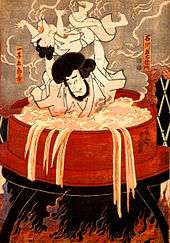Death by boiling
Death by boiling is a method of execution in which a person is killed by being immersed in a boiling liquid. While not as common as other methods of execution, boiling to death has been practised in many parts of Europe and Asia. Due to the lengthy process, death by boiling is an extremely painful method of execution.
Executions of this type were often carried out using a large vessel such as a cauldron or a sealed kettle filled with a liquid such as water, oil, tar, or tallow, and a hook and pulley system.[1]
Historical practice
Europe

In England, the ninth statute passed in 1531 (the 22nd year of the reign of King Henry VIII) made boiling alive the prescriptive form of capital punishment for murder committed by poisoning, which by the same Act was defined as high treason.[2] This arose from a February 1531 incident in which the Bishop of Rochester's cook, Richard Roose, gave several people poisoned porridge, resulting in two deaths.[3] A partial confession having been extracted by torture, the sentence was thus imposed by attainder and without benefit of clergy.[4] A contemporary chronicle reports the following:[5]
He roared mighty loud, and divers women who were big with child did feel sick at the sight of what they saw, and were carried away half dead; and other men and women did not seem frightened by the boiling alive, but would prefer to see the headsman at his work.
Boiling to death was employed again in 1542 for a woman, Margaret Davy,[6] who had also used poison.[7][8] During the reign of Edward VI, in 1547, the 1531 act was repealed.[4]
Numerous persons have been boiled to death in Scotland. For example, with the consent of Jon Haraldsson, the "Bloody Earl" of Orkney, the bishop of Caithness, Adam of Melrose, and a monk named Surlo are said to have been boiled to death by angry husbandmen in 1222 over the bishop's aggressive means of collecting tithes. Alexander II is said to have executed upwards of eighty persons as a punishment for the crime, and the earl fled his lands.[9] According to the Melrose Chronicle, Adam of Melrose was "burned alive", rather than boiled, and Alexander III executed up to 400.[10] William de Soules, a nobleman involved in a conspiracy against Robert the Bruce, was reputed to be a sorcerer consorting with evil spirits, and was boiled alive in 1321 at Ninestane Rig.[11] Around 1420, Melville, the sheriff of the Mearns and laird of Glenbervie, who was resented for his strictness, was apprehended by some other nobles and thrown into the kettle. The nobles are said to have each taken a spoonful of the brew afterwards.[12]
Boiling as an execution method was also used for counterfeiters, swindlers and coin forgers during the Middle Ages.[13] In the Holy Roman Empire, for example, being boiled to death in oil is recorded for coin forgers and extremely grave murderers. In 1392, a man was boiled alive in Nuremberg for having raped and murdered his own mother.[14] Coin forgers were boiled to death in 1452 in Danzig[15] and in 1471 in Stralsund.[16] Even as late as 1687, a man in Bremen was boiled to death in oil for having been of valuable help to some coin forgers who had escaped justice.[17]
In the Dutch town of Deventer, the kettle that was used for boiling criminals to death can still be seen.[18]
Asia

In 16th-century Japan, the semi-legendary Japanese bandit Ishikawa Goemon was boiled alive in a large kettle-shaped iron bathtub.[19] His public execution, which might have included his entire family, was carried out after he failed to kill warlord Toyotomi Hideyoshi.
In 1675, a Sikh martyr called Bhai Dayala was boiled to death in Delhi after he refused to convert to Islam. He was put into a cauldron full of cold water which was then heated to boiling point. Sikh scriptures record that Dayala recited the Japji of Guru Nanak and the Sukhmani of Guru Arjan as he died.[20]
Modern times
The government of Uzbekistan under Islam Karimov has been alleged to have boiled suspected terrorists.[21]
In a US Department of State document from 2004, the following is written:
During the year, there were no developments or investigations in the following 2002 deaths in custody: Mirzakomil Avazov and Khusnuddin Olimov, members of Hizb ut-Tahrir who were tortured to death in Jaslyk Prison in Karakalpakstan resulting in extensive bruises and burns, the latter reportedly caused by immersion in boiling water.[22]
Former ISIS commander Abu Abboud al-Raqqawi referred to ISIS' brutal execution methods, among which was boiling prisoners alive in engine oil:
Some people were boiled alive in oil. Engine oil. They burned wood on a fire for an hour before throwing the victim into boiling oil. It's the Tunisians who were responsible for that.[23]
In 2012, American prisoner Darren Rainey was apparently boiled to death by guards in a prison in Florida, suffering burns to 90% of his body.[24]
Depictions in Western culture
Early reports of cannibals from places in the Pacific, such as Fiji and Papua New Guinea, killing western Christian missionaries were assumed to involve some form of boiling alive.[25] This became a fertile ground for film makers and especially cartoonists, whose clichéd depiction of tourists or missionaries sitting restrained in a large cauldron above a wood fire and surrounded by bone-nosed tribesmen was a staple of popular magazines and films for decades. Examples include the 1985 film adaptation of King Solomon's Mines[26] and the dream sequence in the movie Bagdad Café.[27]
References
- Geoffrey Abbott, Amazing True Stories of Execution Blunders, pp. 21–22.
- Anno 22 Henry VIII (1530–31), Chapter 9, in The Statutes of the Realm Vol. 3: The Statutes of King Henry VIII (By Command 1817), Reprint (Dawsons of Pall Mall, London, 1963), p. 326 (HathiTrust).
- Kesselring, K.J. (September 2001), A Draft of the 1531 'Acte for Poysoning', The English Historical Review Vol. 116, No. 468, pp. 894–899, JSTOR 579196.
-

- (S.H. Burke), The Men and Women of the English Reformation (R. Washbourne, London 1870), p. 240 (Google).
- Chisholm 1911.
- Newlin, George (2000), Understanding Great expectations, Westport, Conn.: Greenwood Press, pp. 136, ISBN 978-0-313-29940-7, OCLC 41488673
- Leslie, Frank, Frank Leslie, and Ellery Sedgwick. 1876. Frank Leslie's popular monthly. [New York]: Frank Leslie Pub. House. p 343
- Pinkerton: "A General Collection of the Best and Most Interesting Voyages, Volume 3", London 1809, p. 158. The same tradition is transmitted in "The Scottish journal of topography, antiquities, traditions". Edinburgh: Stevenson and Menzies. 1842: 248. Cite journal requires
|journal=(help) - Soc. Diff. Use. Knowl. (1842), p. 310 in Society for Diffusion of Useful Knowledge (1842). The Biographical Dictionary. London: Longman, Brown, Green, and Longmans. p. 310.
- " The Complete Works of Sir Walter Scott, New York, 1833, p. 216.
- "The new statistical account of Scotland, Volum 18", Edinburgh 1838, pp. 34-35.
- Monter, E. William (2007). A bewitched duchy: Lorraine and its dukes, 1477-1736. Librairie Droz. p. 163. ISBN 978-2-600-01165-5.
- Mayer, M.M: "Kleine Chronik der Reichsstadt Nürnberg: Mit einem Grundrisse, Nuremberg 1847 p. 102,
- Krüger, J.G: " Die beglückte und geschmückte Stadt Lübeck", 1697, p. 20.
- von Klemptzen, N.:"Nicolaus Klemzen vom Pommer-lande und dessen fürsten geschlecht-beschreibung", Stralsund 1771, p. 39.
- "Blätter für literarische Unterhaltung, Volum 1, p. 116, review of "Taschenbuch für vaterländische Geschichte", Berlin 1843.
- "10 Top Tourist Attractions in Arnhem & Easy Day Trips - PlanetWare". planetware.com.
- Goemonburo - Goemon-style bath Archived July 6, 2011, at the Wayback Machine
- Singha, H. S. (2000). The encyclopedia of Sikhism. Hemkunt Press. p. 56. ISBN 978-81-7010-301-1.
- "Uzbekistan: Two Brutal Deaths in Custody". Hrw.org. Retrieved 6 January 2015.
- "Uzbekistan". state.gov.
- https://www.webcitation.org/6QeLM84iK?url=http://www.miamiherald.com/2014/06/25/4200651/for-prison-shower-death-inquiry.html
- "Villagers apologize for cannibal ancestors eating missionary: Weird News, Strange But True Stories, Odd Facts, Bizarre". www.thatsweird.net. Archived from the original on 2010-07-19. Retrieved 2010-07-23.
- "Encyclopedia of Cannibal Movies: K". www.indiefilm.com. Retrieved 2019-11-23.
- Satellite Ground Systems. "Encyclopedia of Cannibal Movies: B". www.indiefilm.com.